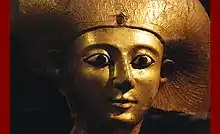Sitdjehuti
Sitdjehuti (or Satdjehuti; “Daughter of Thoth”) was a princess and queen of the late Seventeenth Dynasty of Egypt. She was a daughter of Pharaoh Senakhtenre Ahmose and Queen Tetisheri. She was the wife of her brother Seqenenre Tao and was the mother of Princess Ahmose.
| Sitdjehuti | |
|---|---|
| Queen consort of Egypt | |
 Mask of Sitdjehuty | |
| Spouse | Seqenenre Tao |
| Issue | Ahmose |
| Dynasty | 17th of Egypt |
| Father | Senakhtenre |
| Mother | Tetisheri |
| Religion | Ancient Egyptian religion |
| Sitdjehuti in hieroglyphs | ||||||||||||
|---|---|---|---|---|---|---|---|---|---|---|---|---|
Satdjehuti Sꜣt Ḏḥwty Daughter of Thoth | ||||||||||||
Life
Sitdjehuti was a daughter of Pharaoh Senakhtenre Ahmose and a sister to Pharaoh Seqenenre Tao and the queens Ahhotep and Ahmose Inhapy. She was married to her (half-)brother Seqenenre-Tao and bore him a daughter, Ahmose.[1] On her sarcophagus, she is stated to be the daughter of Tetisheri. Her other name is given as Satibu.[2]
Titles
Sitdjehuti's titles include King's Wife, King's Sister, and King's Daughter. She is mentioned on the mummy shroud of her daughter Ahmose, which was found in the Valley of the Queens (QV47). Ahmose is called the King's Daughter and Queen's Sister. This states that Ahmose was the daughter of King Seqenenre Tao and Sitdjehuti.[3]
Death and burial
Sitdjehuti's mummy was discovered around 1820, along with its coffin, golden mask, a heart scarab, and linens donated by her niece Queen Ahmose-Nefertari. The linen is inscribed with the text:
- Given in the favour of the god's wife, king's wife and king's mother Ahmose Nefertari may she live, so Satdjehuty.[4]
Satdjehuti's coffin lid is now held at Munich while her funerary mask is located in the British Museum (EA 29770).
References
- Dodson, Aidan and Hilton, Dyan. The Complete Royal Families of Ancient Egypt. Thames & Hudson. 2004. ISBN 0-500-05128-3
- Daniel Polz, Der Beginn des Neuen Reiches: zur Vorgeschichte einer Zeitenwende, Walter de Gruyter, 2007, p 350
- Grajetzki, Ancient Egyptian Queens: a hieroglyphic dictionary, 2005
- S. Quirke and J. Spencer, The British Museum Book of Egypt, pg 188-189
External links
| Wikimedia Commons has media related to Sitdjehuti. |
- Mummy Mask of Satdjehuty from the British Museum.
